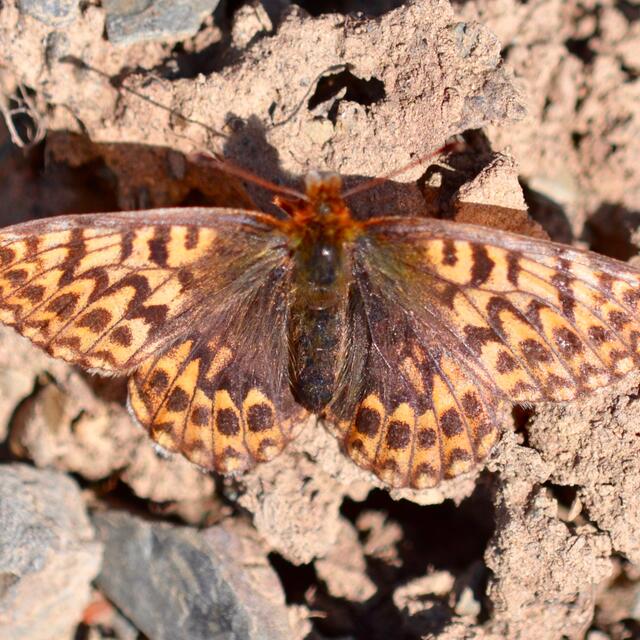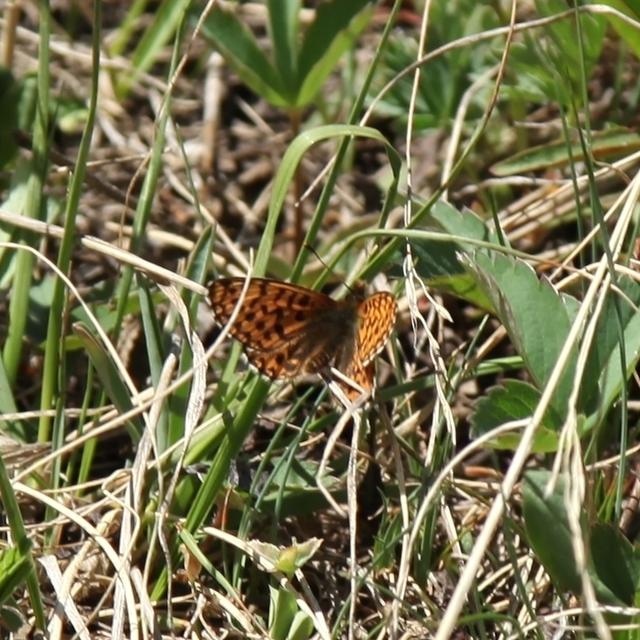Freija Fritillary
Boloria freija (Thunberg, 1791)
Family: Nymphalidae
Subfamily: Heliconiinae
Identification: Upperside tawny to orange-brown; arctic butterflies darker. Underside tawny with characteristic black zigzag median line; arrowhead-shaped white spots in center of wing at outer margin.
Wing Span: 1 3/8 - 1 5/8 inches (3/5 - 4.1 cm).
Life History: Males patrol for females in open areas during warm hours. Females lay eggs on or near the host plants. Caterpillars feed on leaves; fourth-stage caterpillars overwinter.
Flight: One brood from late May to mid-July.
Caterpillar Hosts: Dwarf bilberry (Vaccinium caespitosum) and other plants in the heath family (Ericaceae).
Adult Food: Flower nectar.
Habitat: Open bogs, taiga, tundra, edges of open black spruce bogs, pine forests.
Range: Holarctic. Much of Alaska and Canada; south through the Rocky Mountains to New Mexico; east to the Great Lakes area.
Conservation: Not usually required.
NCGR: G5 - Demonstrably secure globally, though it may be quite rare in parts of its range, especially at the periphery.
Management Needs: None reported.
BAMONA Shop
Please donate!
We depend on donations to keep Butterflies and Moths of North America freely available. We want to express our gratitude to all who showed their support by making a contribution this year. You can donate to support this project at any time.
Advertise with us!
Do you have a product or service that you think would interest BAMONA users? If you would like to advertise on this website, contact us by email, or use the contact form and select the "Advertising" category.
Verified Sightings
Displaying 1 - 24 of 129 verified sightings

Observation date: Jun 11, 2025
Submitted by: Cascade Colors
Region: Grand County, Colorado, United States
Verified by: mikefisher
Verified date: Jun 15, 2025

Observation date: May 24, 2025
Submitted by: Cascade Colors
Region: Grand County, Colorado, United States
Verified by: mikefisher
Verified date: May 25, 2025

Observation date: Jun 02, 2024
Submitted by: James F Parker
Region: Southeast Fairbanks, Alaska, United States
Verified by: davidwdroppers
Verified date: Oct 07, 2024

Observation date: Jun 06, 2024
Submitted by: Cascade Colors
Region: Grand County, Colorado, United States
Verified by: mikefisher
Verified date: Jul 01, 2024

Observation date: May 19, 2024
Submitted by: terrymortier
Region: Douglas County, Wisconsin, United States
Verified by: jmgesell
Verified date: May 22, 2024

Observation date: Jun 04, 2023
Submitted by: terrymortier
Region: Douglas County, Wisconsin, United States
Verified by: jmgesell
Verified date: Aug 20, 2023

Observation date: Jun 11, 2023
Submitted by: CheddahCurt
Region: Alberta, Canada
Verified by: Paul Prappas
Verified date: Jun 12, 2023

Observation date: Jun 03, 2023
Submitted by: alchem30
Region:
Verified by: alchem30
Verified date: Jun 06, 2023

Observation date: Jun 06, 2019
Submitted by: tylerjkrul
Region: Denali, Alaska, United States
Verified by: jwileyrains
Verified date: Feb 21, 2023

Observation date: Jun 05, 2021
Submitted by: frogbandit
Region: Anchorage, Alaska, United States
Verified by: Paul Prappas
Verified date: Feb 11, 2023

Observation date: May 29, 2020
Submitted by: Rick Sinnott
Region: Anchorage, Alaska, United States
Verified by: Paul Prappas
Verified date: Feb 09, 2023

Observation date: Jul 01, 2020
Submitted by: Rick Sinnott
Region: Matanuska-Susitna, Alaska, United States
Verified by: Paul Prappas
Verified date: Feb 08, 2023

Observation date: Jun 20, 2019
Submitted by: Rick Sinnott
Region: Matanuska-Susitna, Alaska, United States
Verified by: Paul Prappas
Verified date: Feb 08, 2023

Observation date: Jun 23, 2019
Submitted by: jsaunders260
Region: Matanuska-Susitna, Alaska, United States
Verified by: Paul Prappas
Verified date: Feb 07, 2023

Observation date: Jun 23, 2019
Submitted by: jsaunders260
Region: Matanuska-Susitna, Alaska, United States
Verified by: Paul Prappas
Verified date: Feb 07, 2023

Observation date: Aug 12, 2022
Submitted by: jrmbutterfly
Region: British Columbia, Canada
Verified by: davidwdroppers
Verified date: Aug 14, 2022

Observation date: Aug 12, 2022
Submitted by: jrmbutterfly
Region: British Columbia, Canada
Verified by: davidwdroppers
Verified date: Aug 14, 2022

Observation date: Jul 12, 2022
Submitted by: Cascade Colors
Region: Summit County, Colorado, United States
Verified by: mikefisher
Verified date: Jul 31, 2022

Observation date: Jun 28, 2022
Submitted by: Cascade Colors
Region: Boulder County, Colorado, United States
Verified by: mikefisher
Verified date: Jul 08, 2022

Observation date: Jun 22, 2022
Submitted by: Cascade Colors
Region: Park County, Colorado, United States
Verified by: mikefisher
Verified date: Jul 06, 2022

Observation date: Jul 18, 2021
Submitted by: Christian.Nunes
Region: Eagle County, Colorado, United States
Verified by: mikefisher
Verified date: Dec 29, 2021

Observation date: Jun 05, 2021
Submitted by: NikkiM
Region: Carbon County, Montana, United States
Verified by: J_Martineau
Verified date: Sep 29, 2021

Observation date: Jun 05, 2021
Submitted by: NikkiM
Region: Carbon County, Montana, United States
Verified by: J_Martineau
Verified date: Sep 27, 2021

Observation date: Jun 26, 2012
Submitted by: bshettler
Region: Manitoba, Canada
Verified by: chalicerae
Verified date: Jul 26, 2021
- 1 of 6
- next ›






